
Ukrainian Journal of Physics
Scope & Guideline
Exploring the Frontiers of Theoretical Physics
Introduction
Aims and Scopes
- Nonlinear Dynamics and Complex Systems:
The journal frequently publishes studies on integrable nonlinear dynamical systems, emphasizing their mathematical modeling and physical implications across various contexts. - Nanotechnology and Materials Science:
Research on the optical, structural, and electronic properties of nanomaterials is a consistent theme, showcasing the journal's commitment to exploring new materials and their applications. - Biophysics and Medical Physics:
The integration of physics principles in biological and medical contexts is evident, with papers focusing on the physical properties of biological tissues and the application of physical methods in medical diagnostics. - Quantum Physics and Cosmology:
The journal addresses foundational topics in quantum mechanics and cosmology, reflecting a deep engagement with theoretical physics and the exploration of fundamental questions in these fields. - Plasma Physics and Magnetism:
Research related to plasma dynamics, magnetism, and the behavior of charged particles in various environments is prominently featured, indicating a strong focus on applied physics. - Statistical Mechanics and Thermodynamics:
The exploration of statistical mechanics principles and thermodynamic properties in diverse systems is a recurrent theme, highlighting the journal's commitment to theoretical physics. - Experimental Techniques and Methodologies:
An emphasis on novel experimental methods, such as spectroscopy and imaging techniques, underscores the journal's role in promoting advancements in experimental physics.
Trending and Emerging
- Quantum Technologies and Quantum Computing:
There is a marked increase in publications addressing quantum technologies, including quantum computing and information theory, indicating a growing interest in harnessing quantum mechanics for practical applications. - Interdisciplinary Approaches in Physics:
Research that integrates physics with other scientific disciplines, such as biophysics, materials science, and nanotechnology, is becoming more prevalent, showcasing a trend towards collaborative and interdisciplinary research. - Advanced Materials and Nanostructures:
The journal is increasingly focusing on the development and characterization of advanced materials, particularly at the nanoscale, reflecting the ongoing advancements in nanotechnology and material science. - Complex Systems and Nonlinear Phenomena:
Emerging studies on complex systems and nonlinear phenomena reveal a growing interest in understanding intricate behaviors in physical systems, which is becoming a significant area of research. - Machine Learning and Data Analysis in Physics:
The application of machine learning techniques for data analysis in experimental physics is gaining traction, indicating a shift towards incorporating computational methods in traditional physics research. - Environmental and Applied Physics:
Research addressing environmental issues and the application of physics principles to solve real-world problems is on the rise, reflecting a broader societal focus on sustainability and ecological challenges.
Declining or Waning
- Classical Mechanics and Traditional Physics:
Research focusing on classical mechanics and traditional physics principles seems to be decreasing, as newer methodologies and interdisciplinary approaches gain traction in the field. - Low-Energy Nuclear Physics:
The frequency of publications related to low-energy nuclear physics appears to be waning, possibly due to the increasing focus on high-energy physics and modern experimental techniques. - Macroscopic Phenomena in Everyday Physics:
Studies centered around macroscopic or everyday physical phenomena are becoming less common, as the journal shifts towards more complex systems and cutting-edge research. - Basic Theoretical Frameworks Without Novel Applications:
Papers that primarily reiterate established theoretical frameworks without presenting innovative applications or insights are declining in frequency, reflecting a preference for novel contributions.
Similar Journals

European Physical Journal Plus
Exploring the Frontiers of Physics and BeyondThe European Physical Journal Plus, published by Springer Heidelberg, is a reputable open-access journal that serves as a vital platform for innovative research across various disciplines, including physics, astronomy, and chemical engineering. With an impressive impact factor reflected by its Q2 ranking in both Fluid Flow and Transfer Processes and Physics and Astronomy (Miscellaneous) categories, this journal plays a crucial role in disseminating high-quality research findings. Since its inception in 2011, it has fostered interdisciplinary collaboration and encourages the exploration of fundamental principles and applications. The journal also boasts a respectable Scopus rank, indicating its solid influence and reach within the scientific community. Researchers, professionals, and students alike will find the journal to be an essential resource for staying abreast of advancements and trends in these dynamic fields, while its open-access model ensures that valuable insights are accessible to a broader audience.

CANADIAN JOURNAL OF PHYSICS
Fostering a vibrant community of physics enthusiasts.The Canadian Journal of Physics, with ISSN 0008-4204 and E-ISSN 1208-6045, is a prominent publication in the field of physics, published by Canadian Science Publishing. Established in 1970, this journal serves as a vital platform for disseminating groundbreaking research and innovative findings across a spectrum of topics within physics and astronomy. With a current Q3 ranking in the miscellaneous category and a respectable Scopus rank of 130 out of 243, the journal ranks within the 46th percentile, confirming its relevance and contribution to the scientific community. Researchers, professionals, and students are encouraged to submit their work for consideration in this esteemed journal, which aims to foster scholarly exchange and advance knowledge in the physical sciences. Although the journal operates under a traditional access model, its rich archive and contemporary insights ensure that it remains a critical resource for anyone invested in the dynamics of physics.

BRAZILIAN JOURNAL OF PHYSICS
Pioneering Discoveries in Brazilian PhysicsBRAZILIAN JOURNAL OF PHYSICS, published by SPRINGER, is a prominent platform dedicated to the dissemination of research within the realm of physics and astronomy. With an ISSN of 0103-9733 and E-ISSN of 1678-4448, this esteemed journal has been contributing to the field since its inception in 1996, and it continues to be pivotal in showcasing innovative studies and breakthroughs. The journal is categorized in the Q4 quartile for the year 2023, reflecting a dedicated focus on advancing knowledge across a variety of disciplines, particularly in general physics and astronomy, where it ranks 126th out of 243 in Scopus rankings. Although it currently does not operate under an open-access model, it remains an invaluable resource for researchers, professionals, and students eager to enhance their understanding of complex physical principles and developments. The journal is committed to promoting high-quality research, bridging gaps in knowledge, and fostering collaboration within the global physics community.
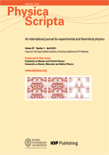
PHYSICA SCRIPTA
Advancing the Frontiers of Physics ResearchPHYSICA SCRIPTA, established in 1970 and published by IOP Publishing Ltd, is a prestigious journal dedicated to the broad fields of physics, encompassing topics such as atomic and molecular physics, condensed matter physics, and mathematical physics. With an impressive commitment to advancing scientific knowledge, it holds a significant standing in the academic community, evidenced by its Q2 and Q3 rankings across various categories in 2023. The journal is instrumental for researchers, professionals, and students seeking to disseminate and engage with high-quality research, fostering collaboration and innovation within the field. Although it currently does not offer open access options, its robust editorial standards ensure the dissemination of impactful studies, contributing to its rising citation metrics. Published from the United Kingdom, PHYSICA SCRIPTA continues to be a vital resource for contemporary developments in physics, paving the way for future discoveries.
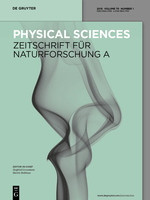
ZEITSCHRIFT FUR NATURFORSCHUNG SECTION A-A JOURNAL OF PHYSICAL SCIENCES
Illuminating Complex Phenomena with ClarityZEITSCHRIFT FUR NATURFORSCHUNG SECTION A - A JOURNAL OF PHYSICAL SCIENCES is a distinguished journal published by Walter de Gruyter GmbH, based in Germany, that serves as a vital platform for research in the realms of mathematical physics, physical and theoretical chemistry, and broader disciplines within physics and astronomy. Established in 1946, this journal has been a cornerstone for scientists and researchers, providing rigorous peer-reviewed articles that push the boundaries of knowledge in physical sciences. With a notable 2023 Scopus ranking reflecting its respected position in the field—Q3 in mathematical physics, physical and theoretical chemistry, and miscellaneous physics and astronomy—this journal not only emphasizes high-quality research but also enhances the visibility and impact of contributions within these areas. Although it does not currently offer open access, the insights shared in its pages are invaluable for advancing academic inquiry and sparking interdisciplinary collaborations. As it looks ahead to 2024, ZEITSCHRIFT FUR NATURFORSCHUNG SECTION A continues to invite contributions that align with its mission to foster an understanding of complex physical phenomena, making it an essential resource for academics, professionals, and students alike.

ACTA PHYSICA SINICA
Empowering Researchers with Groundbreaking InsightsACTA PHYSICA SINICA is a prominent journal published by the Chinese Physical Society, dedicated to the dissemination of groundbreaking research in the field of physics and astronomy. Established in 1993, this journal has consistently contributed to the scientific community by publishing high-quality articles that cover a wide range of topics within general physics and related disciplines. Although currently classified in Q4 of the physics and astronomy category by Scopus, ACTA PHYSICA SINICA plays an important role in fostering collaboration and communication among researchers in China and around the world. With a substantial readership, this journal is poised to remain a valuable resource for professionals, researchers, and students alike. By providing in-depth analysis and insights, it aims to advance the understanding and application of physical principles in various technological and scientific advancements. The journal is accessible via subscription, ensuring that contributors and readers can engage with the evolving landscape of physics research. For more information, visit the publisher's website.

JOURNAL OF THE KOREAN PHYSICAL SOCIETY
Connecting Innovators in Physical ScienceJOURNAL OF THE KOREAN PHYSICAL SOCIETY is a prominent academic journal dedicated to advancing the field of physics, published by the prestigious Korean Physical Society. With its extensive contribution to the scientific community since its inception in 1996, this journal serves as an essential platform for the dissemination of innovative research findings in various branches of physical science. Despite its current categorization in Q4 and a ranking reflecting its early-stage impact relative to peers, it remains a valuable resource for researchers, professionals, and students eager to explore developments in general physics and astronomy. The journal is accessible in both print and electronic formats, making it convenient for a global audience. Each issue aims to foster collaboration and knowledge-sharing within the field, ensuring that it remains relevant and instrumental in shaping future research directions. Located in South Korea, the journal continues to nurture a vibrant academic community, contributing to the ongoing dialogue in the global scientific arena.
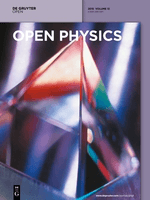
Open Physics
Unlocking the potential of open research in physics and astronomy.Open Physics, published by DE GRUYTER POLAND SP Z O O, is a leading open access journal dedicated to advancing the field of physics and astronomy. Established in 2015, this journal not only promotes the dissemination of innovative research but also emphasizes accessibility, allowing researchers, professionals, and students alike to freely engage with the latest advancements in various physics disciplines. With an impact factor that positions it within the Q3 category of the broader physics and astronomy community, Open Physics currently holds a respectable ranking of #102 out of 243 journals in its field according to Scopus, placing it in the 58th percentile. The journal encourages rigorous scholarship and the sharing of knowledge within a collaborative environment. Based in Germany, with its editorial office located in Warsaw, Poland, Open Physics is dedicated to fostering international dialogue and interdisciplinary research, making it an essential resource for those shaping the future of physical sciences.
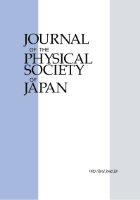
JOURNAL OF THE PHYSICAL SOCIETY OF JAPAN
Illuminating the Path of Scientific Inquiry since 1946The JOURNAL OF THE PHYSICAL SOCIETY OF JAPAN, published by the Physical Society of Japan, has been at the forefront of advancing knowledge in the field of Physics and Astronomy since its inception in 1946. With a commendable reputation reflected in its Q2 ranking within its category for 2023, this journal serves as a vital platform for disseminating high-quality research and innovative concepts. Researchers and professionals alike can engage with cutting-edge studies and reviews that span a diverse range of topics pivotal to the physical sciences. Although the journal does not currently operate with an open access model, it maintains a robust impact on the global physics community, evidenced by its placement in the 59th percentile among a competitive pool of 243 journals. With an unwavering commitment to bridging theory and application, the JOURNAL OF THE PHYSICAL SOCIETY OF JAPAN continues to inspire and cultivate scholarly discourse and collaboration across disciplines.
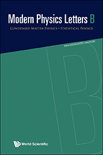
MODERN PHYSICS LETTERS B
Exploring contemporary challenges in physics research.MODERN PHYSICS LETTERS B, published by World Scientific Publishing Co Pte Ltd, is a pivotal journal in the fields of Condensed Matter Physics and Statistical and Nonlinear Physics. With an ISSN of 0217-9849 and an E-ISSN of 1793-6640, this journal has been a prominent platform for innovative physics research since its inception in 1996, catering to a global audience of researchers, professionals, and students alike. Its impact is reflected in its Scopus rankings, with a commendable position in the 65th percentile for Statistical and Nonlinear Physics and the 54th percentile for Condensed Matter Physics. Despite its classification in the Q3 quartile, MODERN PHYSICS LETTERS B is dedicated to advancing knowledge through rapid dissemination of high-quality research, thus playing a critical role in shaping future developments in its disciplines. Published in Singapore, the journal encourages contributions that address contemporary challenges and breakthroughs in physics, fostering an engaged scholarly community.